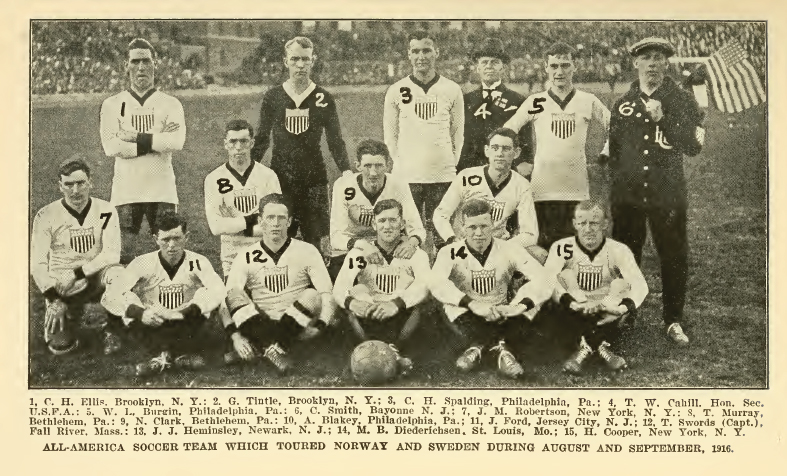
In February 1916, just before the third anniversary of the founding of the United States Football Association and in the third year of the First World War, the USFA Secretary Thomas Cahill received an invitation from C.L. Kornerup, Secretary of the Swedish National Gymnastic and Sporting Association and Vice-President of FIFA to send a team to Sweden. The USFA quickly agreed to the invitation but two questions remained. What team would the association send and how would the young, cash-poor organization pay for the trip?
The second question was soon answered when word came that a $4,000 guarantee — the equivalent of about $100,000 today — had been offered for a team to make the voyage to Sweden. Attention now turned to what team to send abroad. A report in the June 11, 1916 edition of the Philadelphia Inquirer suggests the Swedish Football Association had Bethlehem Steel FC in mind. Interest in the team was understandable, it was the current National Challenge Cup and American Football Association Cup champion. But the Inquirer report said the team’s sponsor, the Bethlehem Steel Company, “would not take the chance of sending its champion soccer team across the ocean” in the middle of a war. While Sweden was a neutral country in the global conflict, as was the United States at this time, not only was Bethlehem Steel a major supplier of war material to Britain, France, and Russia, on May 7, 1915, 1,198 passengers and crew had been killed when a German U-Boat sunk the British ocean liner Lusitania off the Irish coast.
With an August departure date fast approaching, there was no time for a series of tryouts to select the best talent from across the country. Instead, team selection was left “to the knowledge and experience of the members” of the association’s National and International Games Committee. In the end, fourteen players were selected for the “All-America” team, with all but one residing in the northeastern section of the country, leading to claims that the USFA had “discriminated against the western teams in favor of the eastern organizations.” All but two of the players were born in the US. Accompanying the team was a trainer with Cahill as manager.
By the time of the team’s departure from Hoboken aboard the Scandinavia-America line steamship Frederick VIII on July 26, 1916, a schedule of matches against the Swedish and Norwegian national teams, Swedish club sides, as well as a few baseball games, had been organized. Expectations for the team, which had no opportunity to train together before its departure, were low. The official USFA report in the 1916-17 Spalding Guide relates, “So dubious were American followers of soccer generally as to the outcome of the enterprise, that hardly a handful of enthusiasts gathered at the pier to bid the team good-bye and wish it luck.”
The All-Americans arrived in Stockholm on August 8 after completing their crossing in Christiana (present-day Oslo) the day before. Following a week of training, banquets, and sightseeing, the All-Americans opened the tour against club side Tigrarna Fotbollkubben — actually a combined team made up of players from Hammarby, Kamraterna (IFK Stockholm) Marieberg and Västermalm — at Stockholm’s Olympic Stadium on August 15.
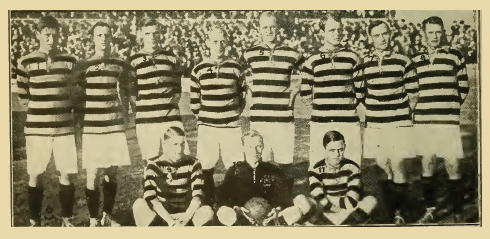
Attendance figures for the match vary — the official USFA report says “approximately 20,000,” while wire reports in U.S. papers say 25,000 — but surviving images and footage from the game show a packed stadium. Also in attendance was the Swedish monarch, King Gustav V, underscoring the high profile of the match and the tour itself.
Aside from a brief account in the official report published in the 1916-17 Spalding Guide, English-language reports on the match are few. A brief three-paragraph wire report was published in US newspapers on August 16. A more detailed report that included lineups for both teams sometimes beginning with the notice “DELAYED BY CENSOR” quickly followed and was the basis of reports in hometown newspapers of US players emphasizing the contributions of their native sons.
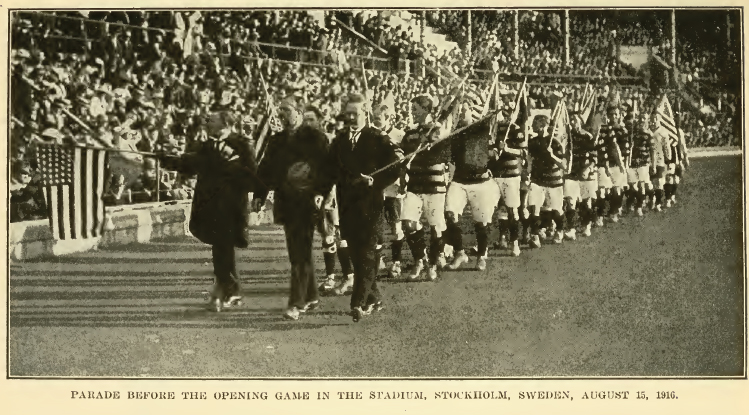
The match at Stockholm Olympic Stadium began at 7 pm. Fall River-native Tommy Swords (Fall River Rovers), inside right and captain of the All-Americans, won the toss “for choice of goals” and Tigrarna then kicked off the game. The August 17 report in the Philadelphia Inquirer says, “The speed of the Americans at once became manifest and, quickly overcoming the earnestness inseparable from the experience of their first international game on foreign soil, the visitors concentrated their attack upon the Stockholm goal with such determination that it required all of the resourcefulness of Almquist, the giant goal tender, to prevent scoring.” Throughout the first 30 minutes of the match “the Yankees kept up their fast gait” before “visibly” tiring and the momentum of the match shifted to the home side. Philadelphia-born left-back Dick Spalding (Disston) now “served the American team with conspicuous effectiveness, repeatedly earning the applause of the crowd, which was well versed in the fine points of the game.” New York City’s The Sun reported “the American custodian,” Harrison, New Jersey’s George Tintle (Brooklyn Celtics), “likewise acquitted himself with glory.” The half ended with neither side scoring.
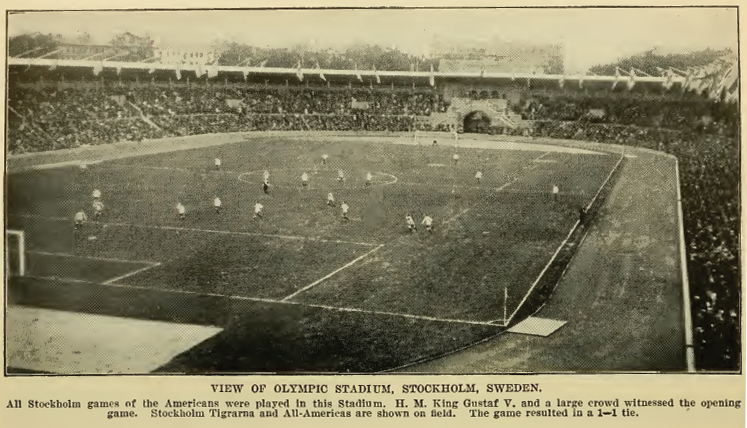
During the halftime break, the USFA report describes, the Swedish monarch summoned Cahill to the royal box “and in a brief address thanked the USFA, through him, for sending the team over, complimented the association on its enterprise and daring in sending abroad an athletic team during war time and dilated upon the increased good fellowship between the United States and Sweden which, he said, would result from the soccer competition. Mr. Cahill responded, thanking the King for his expressions and voicing an appreciation of the attitude of the Swedish people toward the team.”
After the resumption of play, the match remained scoreless for thirty minutes. Then, Kearny, New Jersey’s James Ford (Jersey AC), playing at outside right, “by brilliant individual work, took the ball up in the right way” before centering to center forward and fellow Kearny native John Heminsley (Newark Scottish Americans). Heminsley “timed the ball nicely and, turning on his heel, sent a smashing shot to the Stockholm net, which successfully evaded Almquist, and the Americans were off in the lead.”
The lead was short-lived. Five minutes after the visitors scored, “the home forwards massed in front of the Americans goal and Gunnarson, the inside left, found an opening through which he propelled the ball, tieing the score.” In the stands, “pandemonium broke loose.”
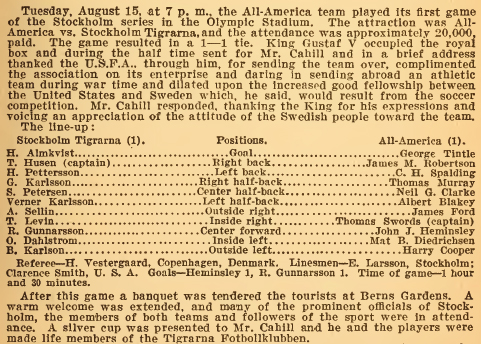
In the remaining ten minutes “both sides strived with might and main to get the point which would mean victory, but without avail,” and the game finished with the sides level at 1-1. Match reports highlight “several conspicuous spurts down the left wing” by Newark, New Jersey’s Harry Cooper (Continental FC). Center halfback Neil Clarke (Bethlehem Steel FC) and right halfback Thomas Murray (Bethlehem Steel FC), both Scottish-born, “were of valuable assistance in the halfback division.” After the match, the US players were treated to a banquet. At the banquet, the official report describes, “A silver cup was presented to Mr. Cahill and he and the players were made life members of the Tigrarna Fotbollklubben.”
On August 20, 1916, the Americans played the USFA’s first official international, facing Sweden at Stockholm Olympic Stadium. Konrad Törnqvist opened the scoring with a goal in the seventh minute for the home team before Dick Spalding equalized with the first official US full international goal in the 22nd minute. Charles Ellis (Brooklyn Celtic) scored in the 53rd minute, and Harry Cooper tallied in the 68th minute. Törnqvist scored again in the 81st minute and the match ended in a 3-2 victory for the Americans. At Frogner Stadium in Christiana (Oslo) on September 3, the All-Americans drew 1-1 with Norway, Ellis again scoring for the U.S. Given the Americans finished the match with only nine players after inside left Matt Diederichsen of St. Louis (Innisfails) was injured in the 35th minute, and Bayonne, New Jersey’s Clarence Smith (Babcox & Wilcox) was unable to continue at left halfback in the second half, the draw was a considerable achievement. During the tour, the team played six matches in total, winning three, losing one, and drawing two. The USFA wouldn’t field another national team side until the 1924 Olympics.
Sources
“All American Soccer Team Ties First Game,” St. Louis Star and Times, August 16, 1916, 10.
“American Soccers Play Tie Contest,” The Sun (New York), August 17, 1916, 13.
Farnsworth, Ed. “Philly and the first USA international tour.” The Society for American Soccer History. Accessed August 26, 2020. https://www.ussoccerhistory.org/philly-and-the-first-usa-international-tour/.
Metz, Lance E. “Bethlehem Steel: The Rise and Fall of an Industrial Giant.” Pennsylvania Legacies 6, no. 2 (2006): 10-15. http://www.jstor.org/stable/27765048.
Rex, “The All-America Team Tour of Norway and Sweden,” Spaldings Official “Soccer” Football Guide, 1916-17, ed. Thomas W. Cahill (New York, American Sports Publishing Company), 4-15.
“Soccer Champs Will Not Tour Sweden,” Philadelphia Inquirer, June 11, 1916, Sporting Section 1.
“Soccer Football Squad to Sail for Europe July 26,” Columbus Daily Enquirer, July 22, 1916, 5.
“Soccer Trouble Ended,” Fall River Daily Herald, August 16, 1916, 4.
“Sverige 2-3 USA.” Svenska Fotbollförbundet. Accessed August 26, 2020. https://www2.svenskfotboll.se/landslag/landslagsdatabas/information/?scr=result&fmid=1567933.
“Yankee Soccerists in Drawn Game,” Philadelphia Inquirer, August 17, 1916, 12.
“Yankee Sockers Tie First Match,” Brooklyn Daily Eagle, August 16, 1916, 16.
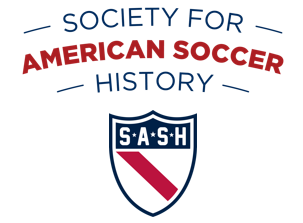
Pingback: Behind the footage: BSFC plays AIK and a select Swedish Provinces team – Society for American Soccer History
Pingback: Stars and Stripes Soccer on the Silver Screen before 1930 – Society for American Soccer History
Pingback: On this day in 1916, first match and win for the USMNT